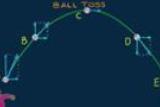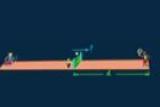Conceptual Integrated Science Explorations
Chapter 7: Gravity
- 7.1 The Falling Apple and the Falling Moon
- 7.2 Newton's Law of Universal Gravitation
- 7.3 Gravity, Distance, and the Inverse-Square Law
- 7.4 The Universal Constant of Gravitation, G
- 7.A Ocean Tides
- 7.5 Weight and Weightlessness
- 7.6 Projectile Motion
- 7.7 Fast-Moving Projectiles--Satellites
- 7.B Earth Satellites
Projectile Motion
An object in free fall moving sideways is affected by the force of gravity just as if it were not moving sideways. Downward acceleration and sideways motion together results in a curved fall. Duration: 6:52.
Sideways Drop
Bullseye Bob drops a bullet while firing another horizontally, then analyzed in Paul's televised classroom, followed up with vertical and horizontal motion independence. Duration: 9:15.
Ball Toss
Paul shows how the motion of a ball tossed by Phil Physiker can be carefully analyzed, with interesting distinctions.
Tennis-Ball Problem
Paul shows the solution to finding the maximum velocity of a horizontally-moving tennis ball that barely clears the net to remain in the court. Duration: 3:46.
Watch these additional videos to complete this tutorial.
Table of Videos
- Self Study Course Descriptions
-
Chapter 1: About Science
- 1.1 The Nature of Science
- 1.2 A Brief History of Advances In Science
- 1.3 Mathematics and Conceptual Science
- 1.4 The Scientific Method--A Classic Tool
- 1.5 The Scientific Hypothesis
- 1.6 The Value of Scientific Experiment
- 1.7 Facts, Theories, and Laws
- 1.8 Science Has Limitations
- 1.9 Science, Art, and Religion
- 1.10 Technology--The Practical Use of Science
- 1.11 What Is Integrated Science?
- 1.A An Investigation of Sea Butterflies
-
Chapter 2: Newton's First Law
- 2.1 Aristotle On Motion
- 2.2 Galileo's Concept of Inertia
- 2.3 Speed and Velocity
- 2.A Comparing Speeds
- 2.4 Motion Is Relative
- 2.5 Newton's First Law of Motion
- 2.6 Net Force--The Sum of All Forces On an Object
- 2.7 Equilibrium for Objects at Rest
- 2.8 The Support Force--Why We Don’t Fall Through the Floor
- 2.9 Equilibrium for Moving Objects
- 2.B Earth Moves Around the Sun
-
Chapter 3: Newton's Second Law
- 3.1 What Is Acceleration?
- 3.2 Force Causes Acceleration
- 3.3 Mass Is a Measure of Inertia
- 3.4 Mass and Acceleration Are Related
- 3.5 Newton’s Second Law
- 3.6 Friction
- 3.7 Objects In Free Fall Accelerate at the Same Rate
- 3.8 Why Objects in Free Fall Accelerate at the Same Rate
- 3.9 Air Drag
- 3.A Friction In Your Fingertips
- 3.B Gliding
-
Chapter 4: Newton's Third Law
- 4.1 A Force Is Part of an Interaction
- 4.2 Newton's Third Law--Action and Reaction
- 4.3 A Simple Rule Helps Identify Action and Reaction
- 4.4 Action and Reaction On Objects of Different Masses
- 4.5 Action and Reaction Forces Act On Different Objects
- 4.6 The Classic Horse-Cart Problem--A Mind Stumper
- 4.7 Action Equals Reaction
- 4.A Animal Locomotion
- 4.8 Summary of Newton's Three Laws
-
Chapter 5: Momentum
- 5.1 Momentum Is Inertia In Motion
- 5.2 Impulse Changes Momentum
- 5.3 Increasing Momentum—Increasing Force, Time, or Both
- 5.4 Practical Uses of the Impulse-Momentum Relationship
- 5.A The Impulse-Momentum Relationship In Sports
- 5.5 Momentum Is Conserved When No External Force Acts
- 5.6 Momentum Is Conserved In Collisions
-
Chapter 6: Energy
- 6.1 Work--Force x Distance
- 6.2 Power--How Quickly Work Gets Done
- 6.3 Mechanical Energy
- 6.4 Potential Energy Is Stored Energy
- 6.5 Kinetic Energy Is Energy of Motion
- 6.6 The Work-Energy Theorem
- 6.7 Conservation of Energy
- 6.8 Machines--Devices That Multiply Forces
- 6.9 Efficiency--A Measure of Work Done for Energy Spent
- 6.A Alternative Sources of Energy
- 6.B Energy for Life
-
Chapter 7: Gravity
- 7.1 The Falling Apple and the Falling Moon
- 7.2 Newton's Law of Universal Gravitation
- 7.3 Gravity, Distance, and the Inverse-Square Law
- 7.4 The Universal Constant of Gravitation, G
- 7.A Ocean Tides
- 7.5 Weight and Weightlessness
- 7.6 Projectile Motion
- 7.7 Fast-Moving Projectiles--Satellites
- 7.B Earth Satellites
-
Chapter 8: Heat
- 8.1 Thermal Energy
- 8.2 Temperature
- 8.3 Absolute Zero--Nature's Lowest Possible Temperature
- 8.4 What Is Heat?
- 8.5 Heat Units Are Energy Units
- 8.6 The Laws of Thermodynamics
- 8.7 Entropy
- 8.8 Specific Heat Capacity
- 8.A Specific Heat Capacity and Earth's Climate
- 8.9 Thermal Expansion
- 8.10 Heat Transfer: Conduction
- 8.11 Heat Transfer: Convection
- 8.12 Heat Transfer: Radiation
-
Chapter 9: Electricity
- 9.1 Electric Charge Is a Basic Characteristic of Matter
- 9.2 Coulomb's law--The Force Between Charged Particles
- 9.3 Charge Polarization
- 9.4 Electric Current--The Flow of Electric Charge
- 9.5 An Electric Current Is Produced By Electrical Pressure--Voltage
- 9.6 Direct Current and Alternating Current
- 9.7 Ohm's Law--The Relationship Between Current, Voltage, and Resistance
- 9.A Electric Shock
- 9.8 Direct Current and Alternating Current
- 9.9 Electric Power--The Rate of Doing Work
- 9.10 Electric Circuits--Series and Parallel
-
Chapter 10: Magnetism
- 10.1 Magnetic Poles--Attraction and Repulsion
- 10.2 Magnetic Fields
- 10.3 Magnetic Domains
- 10.4 Magnetic Fields Around Electric Currents
- 10.A Earth’s Magnetic Field
- 10.5 magnetic Forces on Moving, Charged Particles
- 10.6 Electromagnetic Induction--How Voltage Is Created
- 10.7 Generators and Alternating Current
- 10.8 The Induction of Fields--Both Electric and Magnetic
-
Chapter 11: Waves and Sound
- 11.1 Special Wiggles--Vibrations and Waves
- 11.2 Wave Motion--Transporting Energy
- 11.3 Two Types of Waves--Transverse and Longitudinal
- 11.4 Sound Travels In Waves
- 11.A Sensing Pitch
- 11.5 Speed of Sound
- 11.6 Sound Can Be Reflected
- 11.7 Sound Can Be Refracted
- 11.B Dolphins and Acoustical Imaging
- 11.8 Forced Vibrations and Natural Frequency
- 11.9 Resonance and Sympathetic Vibrations
- 11.10 Interference--The Addition and Subtraction of Waves
- 11.11 The Doppler Effect
-
Chapter 12: Light and Color
- 12.1 The Electromagnetic Spectrum
- 12.2 Why Materials Are Either Transparent or Opaque
- 12.3 Color Science
- 12.A Mixing Colored Lights
- 12.4 Mixing Colored Pigments
- 12.B Why the Sky Is Blue
- 12.C Why Sunsets Are Red
- 12.D Why Clouds Are White
-
Chapter 13: Properties of Light
- 13.1 Reflection of Light--Light Bouncing Off a Barrier
- 13.2 Refraction--The Bending of Light As Its Speed Changes
- 13.A Illusions and Mirages Are Caused by Atmospheric Refraction
- 13.B Light Dispersion and Rainbows
- 13.3 Diffraction--The Spreading of Light
- 13.4 Interference of Light Waves
- 13.5 Interference Colors by Reflection from Thin Films
- 13.6 Wave Particle Duality--Light Travels as a Wave and Strikes as a Particle
- 13.A Illusions and Mirages Are Caused by Atmospheric Refraction
- 13.B Light Dispersion and Rainbows
-
Chapter 14: The Atom
- 14.1 Discovering the Invisible Atom
- 14.A A Breath of Air
- 14.2 Evidence for Atoms
- 14.B A First Look at the Periodic Table
- 14.3 Protons and Neutrons
- 14.4 Isotopes and Atomic Mass
- 14.5 Electron Shells
-
Chapter 15: Nuclear Energy
- 15.1 Radioactivity
- 15.2 Alpha, Beta, and Gamma Rays
- 15.3 Environmental Radiation
- 15.A Radiation Damage to the Body
- 15.4 Transmutation of the Elements
- 15.5 Half-Life
- 15.B Isotopic Dating
- 15.6 Nuclear Fission
- 15.7 The Mass-Energy Relationship: E = mc(2)
- 15.8 Nuclear Fusion
-
Chapter 16: Elements of Chemistry
- 16.1 Chemistry: The Central Science
- 16.A Research
- 16.2 The Submicroscopic World
- 16.3 Change of Phase
- 16.4 Physical and Chemical Properties
- 16.5 Determining Physical and Chemical Changes
- 16.6 The Periodic Table
- 16.7 Elements and Compounds
- 16.8 Naming Compounds
-
Chapter 17: Bonds and Molecular Attractions
- 17.1 Electron-Dot Structures
- 17.2 The Formation of Ions
- 17.3 Ionic Bonds
- 17.A The Chemistry of Minerals
- 17.4 Metallic Bonds
- 17.5 Covalent Bonds
- 17.6 Polar Covalent Bonds
- 17.7 Molecular Polarity
- 17.8 Molecular Attractions
-
Chapter 18: How Chemical Mix
- 18.1 Most Materials Are Mixtures
- 18.2 The Chemist's Classification of Matter
- 18.3 Making Solutions
- 18.4 Concentration and the Mole
- 18.5 Solubility
- 18.6 Soaps and Detergents
- 18.A Purifying the Water We Drink
-
Chapter 19: How Chemicals React
- 19.1 Chemical Equations
- 19.2 Reaction Rates
- 19.A Catalysts and the Atmosphere
- 19.3 Energy and Chemical Reactions
- 19.4 Chemical Reactions Are Driven By Entropy
-
Chapter 20: Acids, Bases, and Redox
- 20.1 Acid and bases
- 20.2 Relative Strengths of Acids and Bases
- 20.3 Acidic, Basic, and Neutral Solutions
- 20.A Acid Rain and Basic Oceans
- 20.4 Losing and Gaining Electrons
- 20.5 Electrochemistry
- 20.6 Corrosion and Combustion
-
Chapter 21: Organic Compounds
- 21.1 Hydrocarbons
- 21.2 Unsaturated Hydrocarbons
- 21.3 Functional Groups
- 21.4 Alcohols and Ethers
- 21.5 Amine and Alkaloids
- 21.6 Carbonyl Compounds
- 21.7 Polymers
- 21.A The Molecules of Life
-
Chapter 22: The Basic Unit of Life: The Cell
- 22.1 What Is Life?
- 22.A The Big Molecules That Make Up Living Things
- 22.2 What Is a Cell?
- 22.3 The Two Types of Cells: Prokaryotic and Eukaryotic
- 22.B The Microscope
- 22.4 Tour of a Eukaryotic Cell
- 22.5 The Organelles of Eukaryotic Cells
- 22.6 The Cell Membrane
-
Chapter 23: How Cells Work
- 23.1 How Things Get In and Out of Cells
- 23.2 How Do Cells Reproduce?
- 23.3 Enzymes and the Chemical Reactions in Cells
- 23.A ATP Fuels Chemical Reactions in Cells
- 23.4 Photosynthesis
- 23.5 How Cells Get Energy
-
Chapter 24: DNA and Genes
- 24.1 What Is a Gene?
- 24.2 Chromosomes: Packages of Genetic Information
- 24.A The Structure of DNA
- 24.3 How DNA Is Copied
- 24.4 RNA
- 24.5 How Proteins Are Built
- 24.6 Meiosis and Genetic Diversity
-
Chapter 25: How Traits Are Inherited
- 25.1 Mendel's Peas
- 25.2 Mendel's First Law
- 25.3 Mendel's Second Law
- 25.4 More Wrinkles: Beyond Mendelian Genetics
- 25.5 The Human genome
- 25.6 Genetic Mutations
- 25.7 Cancer: A Genetic Disease
- 25.A Environmental Causes of Cancer
-
Chapter 26: The Evolution of Life
- 26.1 The Origin of Life
- 26.A Did Life On Earth Come From Mars?
- 26.2 How Living Things Change Over Time
- 26.3 The Key to Evolution: Natural Selection and How It Works
- 26.4 Adaptation
- 26.B Staying Warm and Keeping Cool: How Animals use Physics in Thermoregulation
- 26.5 Genetics and Evolution
- 26.6 How a New Species Forms
- 26.7 Evidence of Evolution
- 26.8 How Humans Evolved
-
Chapter 27: Diversity of Life
- 27.1 Classifying Living Things
- 27.2 Evolution and Classification
- 27.3 The Three Domains of Life
- 27.4 Bacteria
- 27.5 Archaea
- 27.6 Protists
- 27.7 Plants
- 27.8 Fungi
- 27.9 Animals
- 27.A Coral Bleaching
- 27.B How Birds Fly
- 27.10 Viruses and Prions
-
Chapter 28: Control and Development
- 28.1 How the Human Body Is Organized
- 28.2 The Brain
- 28.3 The Nervous System
- 28.4 How Neurons Work
- 28.A How Fast Can Action Potentials Travel?
- 28.B Endorphins
- 28.5 The Senses
- 28.6 Hormones
- 28.7 Reproduction and Development
- 28.8 The Skeleton and Muscles
-
Chapter 29: Care and Maintenance
- 29.1 Integration of Body Systems
- 29.2 The Circulatory System
- 29.A Hemoglobin
- 29.3 Respiration
- 29.4 Digestion
- 29.5 Nutrition, Exercise, and Health
- 29.B Low-Carb Versus Low-Calorie Diets
- 29.6 Excretion and Water Balance
- 29.7 Keeping the Body Safe: Defense Systems
-
Chapter 30: Ecosystems and Environment
- 30.1 Organisms and Their Environments
- 30.2 Species Interactions in Ecological Communities
- 30.3 Energy Flow in Ecosystems
- 30.A Energy Leaks When Organisms Eat
- 30.4 Kinds of Ecosystems
- 30.B Materials Cycling in Ecosystems
- 30.5 Change In an Ecosystem
- 30.6 Population Studies
- 30.7 Human Population Growth
-
Chapter 31: Plate Tectonics
- 31.1 Earth Science Is an Integrated Science
- 31.2 Earth's Composition
- 31.A Density and Earth's Layers
- 31.3 Earth's Structure
- 31.4 Continental Drift--An Idea Before Its Time
- 31.5 Seafloor Spreading
- 31.B Magnetic Stripes Are Evidence of Seafloor Spreading
- 31.6 The Theory of Plate Tectonics
- 31.C What Forces Drive the Plates?
- 31.7 Plate Boundaries
- 31.D Life In the Trenches
-
Chapter 32: Rocks and Minerals
- 32.1 What Is a Mineral?
- 32.2 Mineral Properties
- 32.3 Types of Minerals
- 32.A The Silicate Tetrahedron
- 32.4 How Do Minerals Form?
- 32.5 What Is Rock?
- 32.6 Igneous Rock
- 32.7 Sedimentary Rock
- 32.B Coal
- 32.8 Metamorphic Rock
- 32.9 The Rock Cycle
-
Chapter 33: Earth's Surface: Land and Water
- 33.1 Survey of the Earth
- 33.2 Folding and Faulting
- 33.3 Mountain Building
- 33.4 Plains and Plateaus
- 33.5 Earth's Waters
- 33.6 The Ocean
- 33.A The Composition of Ocean Water
- 33.7 Fresh Water
- 33.B Water Pollution
-
Chapter 34: Surface Processes
- 34.1 Weathering, Erosion, and Deposition--Agents of Change
- 34.A Weathering
- 34.2 Running Water
- 34.3 Glaciers
- 34.4 Mass Movement
- 34.5 Groundwater
- 34.6 Waves
- 34.7 Wind
-
Chapter 35: Weather
- 35.1 Atmosphere
- 35.A Atmospheric Pressure
- 35.2 The Structure of the Atmosphere
- 35.B Heating the Atmosphere
- 35.3 Temperature Depends of Latitude
- 35.4 Why Are There Seasons?
- 35.5 Flow of the Atmosphere--Wind
- 35.C Wind Chill
- 35.6 Some Winds Are Local--Others Are Global
- 35.D The Coriolis Effect
- 35.7 Ocean Currents Distribute Heat
- 35.8 Water In the Atmosphere
- 35.9 Changing Weather--Air Masses, Fronts, and Cyclones
-
Chapter 36: Earth's History
- 36.1 A Model of Earth's History
- 36.2 Telling Relative Time
- 36.A Dating a Rock--Telling AbsoluteTime
- 36.3 The Geologic Time Scale
- 36.B Precambrian Time
- 36.C The Paleozoic Era
- 36.D The Permian Extinction
- 36.E The Mesozoic Era
- 36.F The Cretaceous Extinction
- 36.G The Cenozoic Era
-
Chapter 37: Environmental Geology
- 37.1 Earthquakes
- 37.2 Tsunami
- 37.3 Volcanoes
- 37.4 Hurricanes
- 37.5 Earth's Past ad Present Climate
- 37.A Natural Causes of Climate Change
- 37.B Future Climate--A Warmer Earth?
-
Chapter 38: The Solar System
- 38.1 Earth's Moon
- 38.2 Eclipses—The Shadows of Earth and the Moon
- 38.3 Tour of the Solar System
- 38.A How Did the Solar System Form?
- 38.4 The Sun
- 38.5 The Inner Planets
- 38.6 The Outer Planets
- 38.B What Makes a Planet Suitable for Life?
- 38.7 Asteroids, Comets, and Meteoroids
-
Chapter 39: The Universe
- 39.1 Seeing Stars
- 39.2 The Light-year
- 39.3 The Birth of Stars
- 39.4 The Evolution and Death of Stars
- 39.5 The Bigger They Are, the Harder They Fall—Supernovae
- 39.6 Black Holes
- 39.7 Galaxies
- 39.A SETI
- 39.8 The Big Bang




